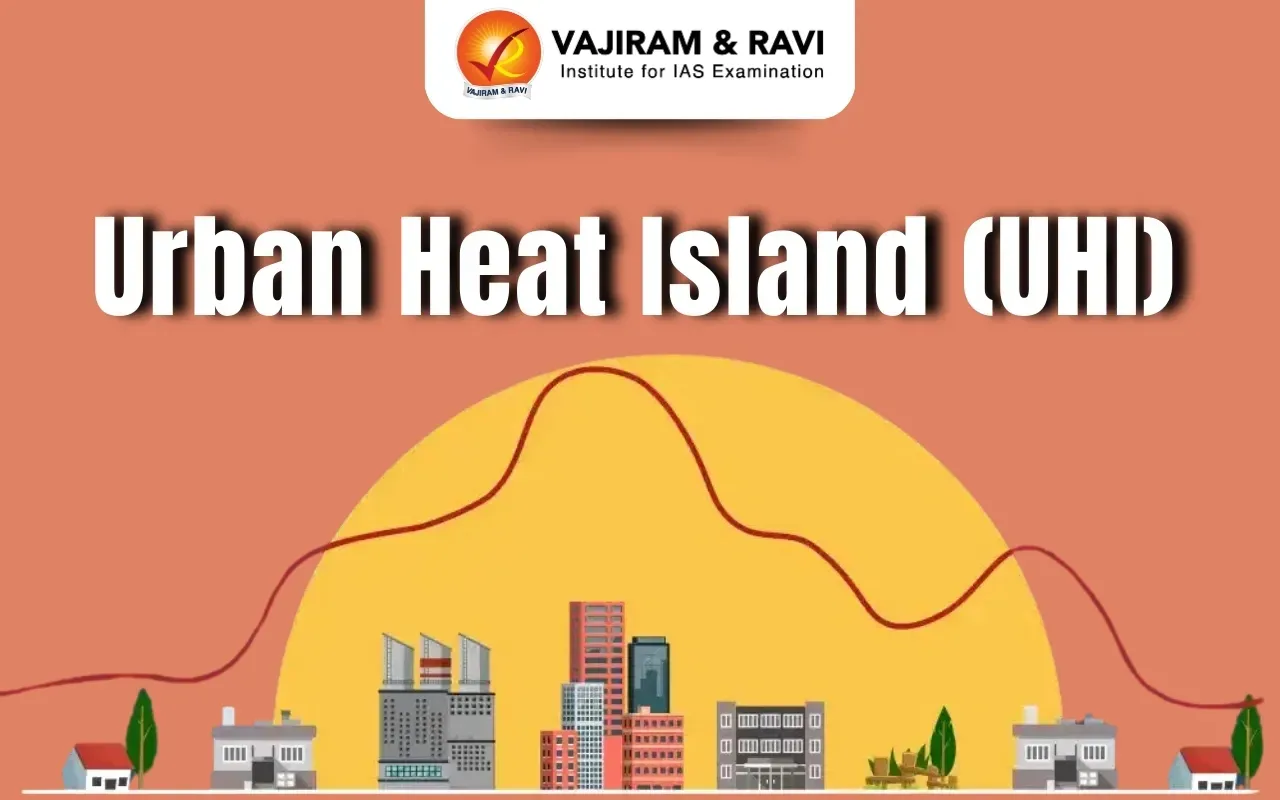Urban Heat Island Latest News
The Telangana Socio-Economic Outlook 2025 report reveals that Hyderabad is experiencing increased nighttime heat stress due to the urban heat island effect.
About Urban Heat Island
- The UHI effect is a climatic phenomenon observed in urban areas, where temperatures are significantly higher than in surrounding rural areas.
- This discrepancy in temperature is attributed to human activities and urban development, which alter land surfaces and environments.
- It is the result of an accumulation of factors, the main ones being:
- Reduced green spaces and natural soils: Urbanization contributes to shrinking vegetation in cities (trees, lawns, etc.), resulting in insufficient shading and evapotranspiration, a process that naturally cools the air.
- Density of buildings and infrastructure: Concrete or asphalt buildings and roads store more heat than vegetated areas, thus exacerbating urban warming.
- Urban layout: narrow streets and tall buildings create urban canyons where warm air is less able to circulate, amplifying the effect of UHIs.
- Heat released by human activities: Road traffic, air conditioning systems, and industrial activities generate heat, which is then trapped by greenhouse gases (such as carbon dioxide) that act as a barrier.
- The combined effect of all these factors, together with global warming and increasingly high temperatures, leads to the development of this urban microclimate.
- The term “Urban Heat Island” originates from the visual representation of temperature distribution maps, where urban areas are depicted as “islands” of higher temperatures amidst cooler rural “seas.”
- The heat of the sun is absorbed during the day, only to be released very slowly at night, which limits the cooling of the air, thus contrasting with the cooling in the outlying rural areas.
- Temperature differences at night can be as much as 12°C.
Urban Heat Island FAQs
Q1. What is the concept of urban heat island?
Ans. An urban heat island, or UHI, is a metropolitan area that’s a lot warmer than the rural areas surrounding it.
Q2. How does vegetation help in reducing the UHI effect?
Ans. By providing shade and promoting evapotranspiration.
Q3. What role does urban layout play in intensifying the UHI effect?
Ans. Tall buildings and narrow streets trap heat, creating urban canyons.
Source: TOI
Last updated on December, 2025
→ Check out the latest UPSC Syllabus 2026 here.
→ Join Vajiram & Ravi’s Interview Guidance Programme for expert help to crack your final UPSC stage.
→ UPSC Mains Result 2025 is now out.
→ UPSC Notification 2026 is scheduled to be released on January 14, 2026.
→ UPSC Calendar 2026 is released on 15th May, 2025.
→ The UPSC Vacancy 2025 were released 1129, out of which 979 were for UPSC CSE and remaining 150 are for UPSC IFoS.
→ UPSC Prelims 2026 will be conducted on 24th May, 2026 & UPSC Mains 2026 will be conducted on 21st August 2026.
→ The UPSC Selection Process is of 3 stages-Prelims, Mains and Interview.
→ UPSC Result 2024 is released with latest UPSC Marksheet 2024. Check Now!
→ UPSC Prelims Result 2025 is out now for the CSE held on 25 May 2025.
→ UPSC Toppers List 2024 is released now. Shakti Dubey is UPSC AIR 1 2024 Topper.
→ UPSC Prelims Question Paper 2025 and Unofficial Prelims Answer Key 2025 are available now.
→ UPSC Mains Question Paper 2025 is out for Essay, GS 1, 2, 3 & GS 4.
→ UPSC Mains Indian Language Question Paper 2025 is now out.
→ UPSC Mains Optional Question Paper 2025 is now out.
→ Also check Best IAS Coaching in Delhi

















